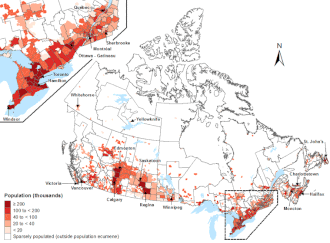
Top left: The Quebec City–Windsor Corridor is the most densely inhabited and heavily industrialized region accounting for nearly 50 percent of the total population
Canada ranks 37th by population among countries of the world, comprising about 0.5% of the world's total, [2] with about 41.5 million Canadians as of 2025. [3] [4] Despite being the second-largest country by total area (fourth-largest by land area), the vast majority of the country is sparsely inhabited, with most of its population south of the 55th parallel north. Just over 60 percent of Canadians live in just two provinces: Ontario and Quebec. Though Canada's overall population density is low, many regions in the south, such as the Quebec City–Windsor Corridor, have population densities higher than several European countries. Canada has six population centres with more than one million people: Toronto, Montreal, Vancouver, Calgary, Edmonton and Ottawa.
Contents
- Historical population overview
- Indigenous peoples
- New France
- British Canada
- Post-confederation
- Components of population growth
- Population by years
- Ephemeral European settlements
- Former colonies and territories
- Canada as a whole since confederation
- Census data by years
- Data projections
- Modern population distribution
- By province and territory
- By cities and municipalities
- First Nations
- See also
- Notes
- References
- Further reading
- External links
The large size of Canada's north, which is currently not arable, and thus cannot support large human populations, significantly lowers the country's carrying capacity. In 2021, the population density of Canada was 4.2 people per square kilometre. [5]
The historical growth of Canada's population is complex and has been influenced in many different ways, such as Indigenous populations, expansion of territory, and human migration. Immigration has been, and remains, the most important factor in Canada's population growth. [6] The 2021 Canadian census counted a total population of 36,991,981, an increase of around 5.2 per cent over the 2016 figure. [7] [8] Between 1990 and 2008, the population increased by 5.6 million, equivalent to 20.4 per cent overall growth. [9]




